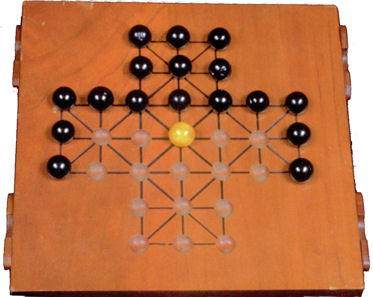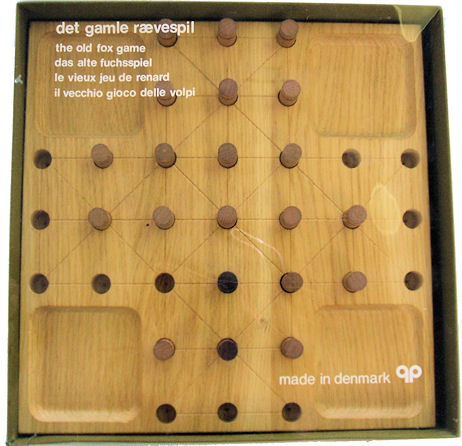
This Webpage features a number of "Fox and Geese" gameboards in the collection. Compare this Viking game with another game which uses a similar design - the "Solitare Puzzle".
In addition to the traditional Medieval European game which is played on the board to the left, a 19th century commemorative "War Game" under the general name of Siege, is also played on this board. For more information about how to play the game of Siege, click on the left menu item "Asalto Games".
Over a period of time in Scandinavia, a number of games making use of this board were evolved . Most of these Viking games are classified as Alsalto Games, and information about these can be viewed by clicking on the "Viking Games" item in the left menu.
The photograph above is of a board manufactured by Berea College Student Industries, Berea, Kentucky, U.S. In 1972, the Museum purchased this board through World Wide Games, Delaware, Ohio. As of 2007 similar wooden boards such as this one were still being manufactured by the Student Industries Program at Berea, and were available directly from the College.
The board is handmade of a 7.5" square of cherry wood. There are 33 depressions on the board, each depression is at an intersection of one or more lines etched in the traditional Fox and Geese pattern. On the sides of the board are grooved holes with rotating covers used for self-storing the marble markers.
The marble "set-up" on the board illustrates the initial manor in which the game begins, that is with 17 black geese, and one orange fox. Because there are variations in the manner in which this game may be played or other games that may be played on this board, additional marbles are included by the supplier. For example, a game with two geese may also be played on this board and is described below.

The photograph on the left is of a Fox and Geese set made in Denmark, acquired by the Museum in 1978.
The cardboard box that holds the set has a clear plastic cover. The board is made of a hardwood and is 24.3cm square x 2cm thick. There are 21 cylindrical playing pieces 1.1cm in diameter and 3cm high. Two of the pieces are stained darker since they are the "foxes".
The object of the game is for the geese to "pen" the fox, or the fox to "capture" twelve geese. The following are the game instructions provided by World Wide Games, Inc.
Begin the game with 17 geese placed on one end of the board with the fox in the middle (as illustrated in the photograph.
The fox moves first; thereafter players alternate. Geese may move from one spot to another along the lines. The fox may move in the say way and in addition may leap over any goose to an unoccupied space beyond or may make a series of leaps when possible. Fox is not obliged to leap when an opening appears, but may move instead.
The fox captures and removes from the board geese that have been jumped (leaped over).
The game is won by the fox if it can capture 12 geese. (At least six geese are required to pen up the fox.) The geese win if they can corner the fox so he cannot move or jump.
If the geese are played skillfully, they usually win. In some cases the game is played with 15 or even 13 geese, or the geese are limited to forward moves, or two foxes are entered.
While there is a long European history associated with this game (see David Parlett, Oxford History of Board Games, 1999, pages 187-188), Berea College indicates that in the 1800's in the Appalachian Highlands this version of the game was played.
It has been a favorite pastime of the "Millboy" and a neighbor while the miller grinds the "turns" of his corn. A roughly drawn board on the upturned box, two grains of red corn (Foxes) and twenty-four white grains (Geese) and two men or boys with time to spare furnish hours of fun for onlookers as well as participants.

The object of the game is for the geese to pen up both foxes so they cannot move or for the foxes to capture twelve of the geese.
A fox moves first and then a goose, each player making one move at a time.
The foxes may move forward, backward, or toward the side and may capture the geese by jumping over them when a hole beyond a goose is empty. The foxes are not required to jump but may move to another hole if one is open. A move or jump must be made on each turn.
The geese may move only forward or sideways, one hole at a time, and are not permitted to jump a fox, but instead try to pen it up so it cannot move or jump.
Last update December 2, 2010